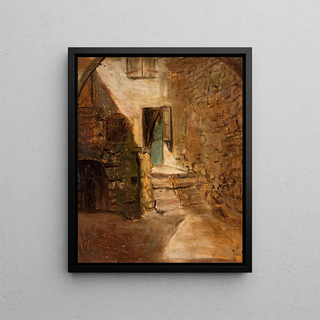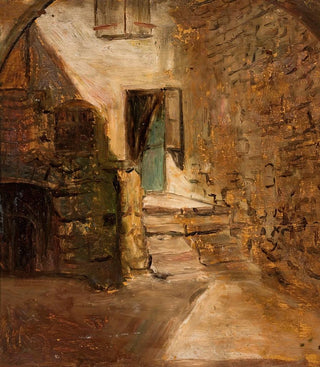Art print | Fragment of an old house - Tadeusz Makowski Source: Reproduction | Fragment d'une vieille maison - Tadeusz Makowski


View from behind

Frame (optional)
In the world of art, some works manage to capture the essence of a bygone era while transcending time. "Fragment of an old house - Tadeusz Makowski" is one such creation that invites deep contemplation. This painting, both simple and emotionally charged, evokes a universe where nostalgia and beauty meet. Through delicate colors and suggestive forms, the piece transports us to a past that is no longer, where every detail tells a story. The house, fragmented, becomes a symbol of collective memory, an echo of past lives that still resonate in our present.
Style and uniqueness of the work
Makowski, with his distinctive style, manages to blend realism and abstraction, creating an atmosphere that is both tangible and ethereal. In "Fragment of an old house," soft hues and blurred contours merge to give life to a scene imbued with melancholy. The artist skillfully plays with light and shadow, emphasizing nuances of material and space. Each brushstroke seems charged with meaning, as if the artist sought to capture not only the appearance of a house but also its soul. This painting does not merely depict a place; it evokes memories, emotions, and a story that resonate deeply within each of us. The way Makowski approaches the structure of the house, fragmenting it, encourages us to reflect on the notions of belonging and identity.
The artist and his influence
Tadeusz Makowski, an emblematic figure of Polish art in the early 20th century, left his mark through his unique vision. Influenced by the Expressionist movement, he developed a style that is his own, blending elements of Polish folk tradition with modernist influences. His ability to incorporate universal themes into local representations allowed him to reach a broad audience. Through his works, Makowski explores the complexities of the human condition, questioning the links between man and his environment. "Fragment of an old house" exemplifies this quest, where the artist does not merely represent

Matte finish

View from behind

Frame (optional)
In the world of art, some works manage to capture the essence of a bygone era while transcending time. "Fragment of an old house - Tadeusz Makowski" is one such creation that invites deep contemplation. This painting, both simple and emotionally charged, evokes a universe where nostalgia and beauty meet. Through delicate colors and suggestive forms, the piece transports us to a past that is no longer, where every detail tells a story. The house, fragmented, becomes a symbol of collective memory, an echo of past lives that still resonate in our present.
Style and uniqueness of the work
Makowski, with his distinctive style, manages to blend realism and abstraction, creating an atmosphere that is both tangible and ethereal. In "Fragment of an old house," soft hues and blurred contours merge to give life to a scene imbued with melancholy. The artist skillfully plays with light and shadow, emphasizing nuances of material and space. Each brushstroke seems charged with meaning, as if the artist sought to capture not only the appearance of a house but also its soul. This painting does not merely depict a place; it evokes memories, emotions, and a story that resonate deeply within each of us. The way Makowski approaches the structure of the house, fragmenting it, encourages us to reflect on the notions of belonging and identity.
The artist and his influence
Tadeusz Makowski, an emblematic figure of Polish art in the early 20th century, left his mark through his unique vision. Influenced by the Expressionist movement, he developed a style that is his own, blending elements of Polish folk tradition with modernist influences. His ability to incorporate universal themes into local representations allowed him to reach a broad audience. Through his works, Makowski explores the complexities of the human condition, questioning the links between man and his environment. "Fragment of an old house" exemplifies this quest, where the artist does not merely represent






